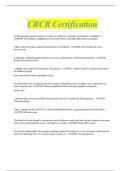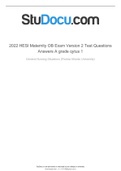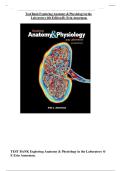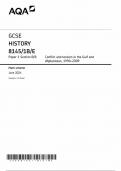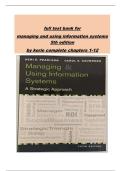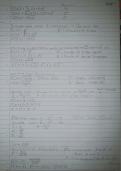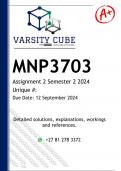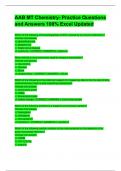THEME 1: THE MODERN WORLD SYSTEM, THE NATION STATE AND THE WORLD
ORDER: INTRODUCTION: INTERNATIONAL POLITICAL SYSTEM
Micro-Analysis/Approach: Also known as a foreign policy analysis focuses on individual
actors in international politics. It seeks to analyze individual actors at the state level and how
their involvement influences issues in the international system. The main actor in this
perspective is the state which is viewed to have certain interests and a strategy to protect or
pursue them in the international arena.
Macro-Analysis/Approach: Also known as systems analysis focuses on the interaction
between actors in the international system. From the state-centric point of view, it analysis
the interaction of states and how they pursue their national interests in the international
system. The reason it is called systems analysis is that it looks at how power is regulated,
and relationships navigated in the international arena. Macro-analysis also brings into the
picture other actors in the system.
INTERNATIONAL SYSTEM IN CONTEXT: WHAT IS THE INTERNATIONAL SYSTEM?
A system is defined as a set of assembled units or a form of interdependence. Therefore,
when we look at the international system, we seek to analyze the interaction between
different interconnected and interdependent units. According to Roskin and Berry (1997:5)
system is defined within the context of interaction and how through interaction the
components or the actors in this regard influence each other. It is therefore important to
mention that in the process of interaction among the components or the actors the system is
bound to be either stable or unstable. Secondly, there is also a notion that as it evolves, the
system is bound to become self-correcting especially when lessons from the past are
learned and new policies are formulated to regulate the interaction within the components.
When analyzing the system it is important to note the following:
Interdependence: In order to understand the system it is important to note the
interdependence of identifiable components, parts, or even in the aspect of the international
system the actors. These components/parts/actors can be material or immaterial (meaning
that they could be significant or insignificant), but their activities within the system are
regarded as purposeful.
Feedback Process: As has been mentioned earlier that due to their interdependence, these
components somehow influence each other. The interaction and reaction of these
components do have a way of influencing the system hence an understanding of the
,feedback process is important. For example, how does the action of state A influence state
B, and thus how does that affect the interaction in the system.
Influence: As mentioned above due to interdependence the nature and behavior of the
components/actors do influence the functioning of the system as a whole.
Complexity: The system can be defined as a complex whole or the composition of and the
interaction between the parts.
Definitions: The system is bounded by definable system boundaries. It is said that these
boundaries can be either physical or purely analytical.
Subsystems: A most complex system consisting of distinguishable subsystems
Introduction: The topics dealt with earlier sought to give an introduction to the study of
international political economy. They laid the foundation for the key pillars of analysis in
international political dynamics. One defined and discussed the world-systems approach. It
was discussed on the premise that the current world system is capitalist by nature and is
defined by skewed global relations dominated by the global North. It also sought to outline
the state of Africa within the context of coloniality which condemned it to the abyss of the
periphery in the system. The other topic dealt with was the modern nation-state and it sought
to trace the emergence of nation-states as the main actors in the international system. We
traced the emergence of this modern nation-state from the peace of Westphalia and
concluded that it is dominated by the capitalist world. Issues dealt with were the definitions
and the key characteristics of the state. Also, there we concluded that Africa’s evolution
or the emergence of the modern nation-state system is a by-product of colonialism. As we
conclude theme one we will look at the world order about what we have discussed
Definitions: Sorenson (2006) defines the world order as a governing arrangement among the
states. In the previous topics, we mentioned that as the main actors in the international
system states operated or interact on the premise of sovereignty. That is, they do not regard
anyone as superior to them. Secondly, states interact at that level to pursue and protect their
national interest. We, therefore, conclude that the international system is chaotic by nature,
as there is no central supreme authority. However, it is imperative to mention that due to the
nature of the system, states have found a way of self-governance through the world order.
Kok et al (2020) think that, unlike the world system that is static and defined by its capitalist
posture, the world order changes from time to time. These changes are highly influenced by
the power dynamics in international dynamics.
Origins:
,In the previous topic, we traced the origin of the modern nation-state from the Peace of
Westphalia Treaty. This treaty defined and outlined the concept of the nation-state. It is from
this premise that the World Order should be traced. Kok et al (2020) posit that the world
order is a political construct that emerged after the Peace of Westphalia was signed and it
operates and transforms with the defined world system. In basic terms, world order cannot
be defined or understood outside the already defined posture of the world system which is
capitalist. The difference between the two is that the world system is static whereas the
world order is fluid.
Hegemony: Kok et al. (2020) think that the world order is managed and maintained by a
strong hegemony that attempts to create stability within the world system. This hegemony
will be defined further when we discuss the power dynamics in the international system
because it speaks to who makes the rules in the system. World Order though has a defined
set of rules is subject to the balance of power in the world system.
Political and Military Power: Maintenance of the global order is through politics and the
military. This is through the systems or machinery of governance like the United Nations
Security Council or by military intervention. The sole purpose of the world order is to
maintain stability and peace in the system. Wherever there seems to be a disorder, the
solution is either political or military. Kosovo and Libya situations come to mind.
Key Components of the World Order: One of the foundations of the modern nation-state is
state sovereignty which defines and determines the state or the position of the state in the
international system. Sovereignty means that there is no other authority within set
boundaries except the state. But then how do we define this sovereignty within the world
order?:
Westphalian Sovereignty: Above we have defined the term sovereignty as outlined post
the signing of the peace of Westphalia. Nimako (2011:22) thinks that this posture of
sovereignty gave rise to the colonialization of Africans and placed Africa at the periphery of
the world system. This is based on the notion that the new-found European states did not
recognize anyone outside their collective. Africa and Asia were up for grabs hence the rush
to colonize them. The fate of Africa was decided at the Berlin conference where it was
carved and subdivided. This process defined and determined the status of Africa on the table
in the international system.
United Nations Sovereignty: It is imperative to note that after WW I a global order or
governance system in the form of the League of Nations was formed and its intended
purpose was to maintain world peace. However, it failed, and the United Nations came to be.
As part of its mandate, it redefine certain constructs and one of those constructs was
, sovereignty. Another assertion by Nimako (2011:22) is that the United Nations' sovereignty
gave rise to decolonization and thus the expansion of the world system. On the other side, it
transformed Africans into subjects of neo-colonial states. What Nimako means is that Africa
was never the master of her destiny and identity, but had to assimilate into the already-
defined structure of the world order.
World order is basically about governance in the world system. The evolution of the world
system and that of the world order help us understand the international political dynamics. It
helps us to understand the inequality that is in the system. As Africans, it also helps us
understand why we occupy the position we are occupying in the system. Kok et al (2020)
say that Africa is part of the world order within the modern world system that is defined and
shaped by the global coloniality of power that continues to maintain the asymmetrical
relationship between the global North and the global South.
Introduction: In the previous topic we dealt with the definition of the modern world system
and briefly outlined key issues and how they influence the interaction. In this topic, we will
deal first with the factors that describe the system and then briefly deal with the timelines in
the evolution of the international system up to the modern world system.
Factors that define the international system: Kok et al (2020) mention three key
factors that define the system.
Tension and Power Hierarchy: The international system is mainly seen as having no
authoritative, directing, and controlling center, and the nature of interaction varies, in the
main, according to the number, behavior, and objectives of the significant units or
subsystems. This approach is a classic approach based on the premise that the system is
anarchic as there is no central power to enforce compliance, however, due to the
interdependence of states, the system is able to regulate itself as the actors develop norms
and systems for self-regulation. However, it is important to acknowledge that the system is
defined by tension power hierarchy. According to Kok et al (2020) in modern days, “the
power hierarchy, can be explained in terms of the tension that exists between the core
(North) and periphery (South) states, in which the powerful and wealthy societies of the
global North (core) dominate and exploit the weak and poor societies from the global South
(periphery).
Instability: The shape and the structure of the international system are not stable. As we
have mentioned above states jostle for power and control. The arrangement of power in the
system has the ability to change and influence the structure of the system. The main cause
for instability can be ascribed to the lack of central authority in the system. Therefore, the
ORDER: INTRODUCTION: INTERNATIONAL POLITICAL SYSTEM
Micro-Analysis/Approach: Also known as a foreign policy analysis focuses on individual
actors in international politics. It seeks to analyze individual actors at the state level and how
their involvement influences issues in the international system. The main actor in this
perspective is the state which is viewed to have certain interests and a strategy to protect or
pursue them in the international arena.
Macro-Analysis/Approach: Also known as systems analysis focuses on the interaction
between actors in the international system. From the state-centric point of view, it analysis
the interaction of states and how they pursue their national interests in the international
system. The reason it is called systems analysis is that it looks at how power is regulated,
and relationships navigated in the international arena. Macro-analysis also brings into the
picture other actors in the system.
INTERNATIONAL SYSTEM IN CONTEXT: WHAT IS THE INTERNATIONAL SYSTEM?
A system is defined as a set of assembled units or a form of interdependence. Therefore,
when we look at the international system, we seek to analyze the interaction between
different interconnected and interdependent units. According to Roskin and Berry (1997:5)
system is defined within the context of interaction and how through interaction the
components or the actors in this regard influence each other. It is therefore important to
mention that in the process of interaction among the components or the actors the system is
bound to be either stable or unstable. Secondly, there is also a notion that as it evolves, the
system is bound to become self-correcting especially when lessons from the past are
learned and new policies are formulated to regulate the interaction within the components.
When analyzing the system it is important to note the following:
Interdependence: In order to understand the system it is important to note the
interdependence of identifiable components, parts, or even in the aspect of the international
system the actors. These components/parts/actors can be material or immaterial (meaning
that they could be significant or insignificant), but their activities within the system are
regarded as purposeful.
Feedback Process: As has been mentioned earlier that due to their interdependence, these
components somehow influence each other. The interaction and reaction of these
components do have a way of influencing the system hence an understanding of the
,feedback process is important. For example, how does the action of state A influence state
B, and thus how does that affect the interaction in the system.
Influence: As mentioned above due to interdependence the nature and behavior of the
components/actors do influence the functioning of the system as a whole.
Complexity: The system can be defined as a complex whole or the composition of and the
interaction between the parts.
Definitions: The system is bounded by definable system boundaries. It is said that these
boundaries can be either physical or purely analytical.
Subsystems: A most complex system consisting of distinguishable subsystems
Introduction: The topics dealt with earlier sought to give an introduction to the study of
international political economy. They laid the foundation for the key pillars of analysis in
international political dynamics. One defined and discussed the world-systems approach. It
was discussed on the premise that the current world system is capitalist by nature and is
defined by skewed global relations dominated by the global North. It also sought to outline
the state of Africa within the context of coloniality which condemned it to the abyss of the
periphery in the system. The other topic dealt with was the modern nation-state and it sought
to trace the emergence of nation-states as the main actors in the international system. We
traced the emergence of this modern nation-state from the peace of Westphalia and
concluded that it is dominated by the capitalist world. Issues dealt with were the definitions
and the key characteristics of the state. Also, there we concluded that Africa’s evolution
or the emergence of the modern nation-state system is a by-product of colonialism. As we
conclude theme one we will look at the world order about what we have discussed
Definitions: Sorenson (2006) defines the world order as a governing arrangement among the
states. In the previous topics, we mentioned that as the main actors in the international
system states operated or interact on the premise of sovereignty. That is, they do not regard
anyone as superior to them. Secondly, states interact at that level to pursue and protect their
national interest. We, therefore, conclude that the international system is chaotic by nature,
as there is no central supreme authority. However, it is imperative to mention that due to the
nature of the system, states have found a way of self-governance through the world order.
Kok et al (2020) think that, unlike the world system that is static and defined by its capitalist
posture, the world order changes from time to time. These changes are highly influenced by
the power dynamics in international dynamics.
Origins:
,In the previous topic, we traced the origin of the modern nation-state from the Peace of
Westphalia Treaty. This treaty defined and outlined the concept of the nation-state. It is from
this premise that the World Order should be traced. Kok et al (2020) posit that the world
order is a political construct that emerged after the Peace of Westphalia was signed and it
operates and transforms with the defined world system. In basic terms, world order cannot
be defined or understood outside the already defined posture of the world system which is
capitalist. The difference between the two is that the world system is static whereas the
world order is fluid.
Hegemony: Kok et al. (2020) think that the world order is managed and maintained by a
strong hegemony that attempts to create stability within the world system. This hegemony
will be defined further when we discuss the power dynamics in the international system
because it speaks to who makes the rules in the system. World Order though has a defined
set of rules is subject to the balance of power in the world system.
Political and Military Power: Maintenance of the global order is through politics and the
military. This is through the systems or machinery of governance like the United Nations
Security Council or by military intervention. The sole purpose of the world order is to
maintain stability and peace in the system. Wherever there seems to be a disorder, the
solution is either political or military. Kosovo and Libya situations come to mind.
Key Components of the World Order: One of the foundations of the modern nation-state is
state sovereignty which defines and determines the state or the position of the state in the
international system. Sovereignty means that there is no other authority within set
boundaries except the state. But then how do we define this sovereignty within the world
order?:
Westphalian Sovereignty: Above we have defined the term sovereignty as outlined post
the signing of the peace of Westphalia. Nimako (2011:22) thinks that this posture of
sovereignty gave rise to the colonialization of Africans and placed Africa at the periphery of
the world system. This is based on the notion that the new-found European states did not
recognize anyone outside their collective. Africa and Asia were up for grabs hence the rush
to colonize them. The fate of Africa was decided at the Berlin conference where it was
carved and subdivided. This process defined and determined the status of Africa on the table
in the international system.
United Nations Sovereignty: It is imperative to note that after WW I a global order or
governance system in the form of the League of Nations was formed and its intended
purpose was to maintain world peace. However, it failed, and the United Nations came to be.
As part of its mandate, it redefine certain constructs and one of those constructs was
, sovereignty. Another assertion by Nimako (2011:22) is that the United Nations' sovereignty
gave rise to decolonization and thus the expansion of the world system. On the other side, it
transformed Africans into subjects of neo-colonial states. What Nimako means is that Africa
was never the master of her destiny and identity, but had to assimilate into the already-
defined structure of the world order.
World order is basically about governance in the world system. The evolution of the world
system and that of the world order help us understand the international political dynamics. It
helps us to understand the inequality that is in the system. As Africans, it also helps us
understand why we occupy the position we are occupying in the system. Kok et al (2020)
say that Africa is part of the world order within the modern world system that is defined and
shaped by the global coloniality of power that continues to maintain the asymmetrical
relationship between the global North and the global South.
Introduction: In the previous topic we dealt with the definition of the modern world system
and briefly outlined key issues and how they influence the interaction. In this topic, we will
deal first with the factors that describe the system and then briefly deal with the timelines in
the evolution of the international system up to the modern world system.
Factors that define the international system: Kok et al (2020) mention three key
factors that define the system.
Tension and Power Hierarchy: The international system is mainly seen as having no
authoritative, directing, and controlling center, and the nature of interaction varies, in the
main, according to the number, behavior, and objectives of the significant units or
subsystems. This approach is a classic approach based on the premise that the system is
anarchic as there is no central power to enforce compliance, however, due to the
interdependence of states, the system is able to regulate itself as the actors develop norms
and systems for self-regulation. However, it is important to acknowledge that the system is
defined by tension power hierarchy. According to Kok et al (2020) in modern days, “the
power hierarchy, can be explained in terms of the tension that exists between the core
(North) and periphery (South) states, in which the powerful and wealthy societies of the
global North (core) dominate and exploit the weak and poor societies from the global South
(periphery).
Instability: The shape and the structure of the international system are not stable. As we
have mentioned above states jostle for power and control. The arrangement of power in the
system has the ability to change and influence the structure of the system. The main cause
for instability can be ascribed to the lack of central authority in the system. Therefore, the

